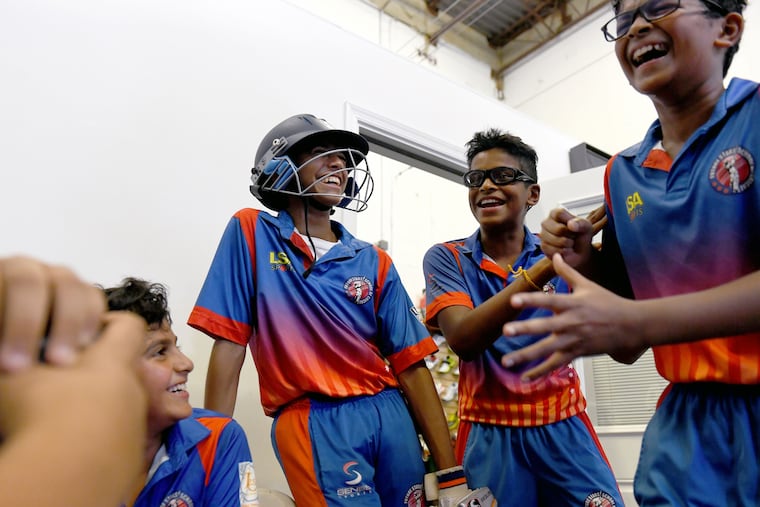Crickets! Why are these young Americans so passionate about the sport of their parents?
A new generation of kids looks to cricket, a sport more popular in their parents' homeland than the U.S. -- for now.

The 13-year-old pressed a napkin against the cavity where his baby tooth had been, keeping his eyes fixed on his teammates running drills.
Thwack! The sound of ball against bat vibrated through the warehouse-turned-training facility in suburban Virginia. Ditching the bloodied paper, Shiv Nair ducked back into line.
Every Wednesday for three hours, Shiv and his teammates come to practice cricket, the game their fathers grew up playing in the countries they left behind. Initially, there were just five boys, ages 6 to 9. They got “absolutely destroyed” in matches against under-14 teams, losing by margins that still make them laugh.
But for reasons even their coach cannot pin down, they kept playing. And year after year, others joined them.
Their Virginia-based youth club, the Future Stars School of Cricket, now has more than 90 players, nearly all U.S.-born children of parents from South Asia. It is part of a broader growth of the game in the United States that is boosting demand for public fields and could change the allocation of recreation dollars in years to come.
Demographic shifts are at the core of the explosion, but academics and cricket enthusiasts say there is something else going on, too: a change in the way first-generation Americans relate to their parents’ home countries.
Growing up in the most ethnically diverse — and technologically adept — generation in U.S. history, these kids can access their cultural heritage in ways distinct from previous generations. They watch highlight reels of faraway matches on YouTube, and follow Indian or Pakistani players on Instagram as easily as their classmates track baseball stars such as Max Scherzer or Juan Soto.
“Things from their ancestral home don’t seem as far away as they once used to,” said Stella Rouse, an associate professor at the University of Maryland who studies the identity politics of millennials. “There’s a more comfortable environment for younger folks now to express things that are different, things that are ‘other.’ ”
One recent evening, Shiv’s team, the Lions, gathered at their training facility in Sterling, Va. A group of fathers chatted in English and Tamil about their own sporting records and the glaring — “unacceptable, really” — shortage of outdoor cricket fields in the Washington suburbs.
At the far end of the warehouse, Shiv, the team captain, got ready to bat. His best friends were around him: Govind Mohandas, the 13-year-old who carpools with Shiv to away games, and Tanush Apte, 11, the “little pet of the group,” who pitches — or “bowls” — with the aggression of someone much older.
Tanush wiped saliva on the ball — a legal and common form of ball tampering — then stared down the length of the AstroTurf. Grinning, Shiv squared up.
Thwack!
» READ MORE: Upper Dublin High School athlete plays with only one arm — and inspires everyone
In the past five years, the number of cricket teams and leagues in and around the nation’s capital has nearly doubled, coaches say, as immigrant adults and their U.S.-born children clamor to play the game.
Sports “can provide something familiar to new migrants when perhaps, on a daily basis, they don’t feel as included in society as they would like,” said Thomas Fletcher, a researcher in northern England who has studied the relationship between South Asian communities and cricket. “Particularly for immigrants of color, it provides a place of safety where they are less likely to be racialized.”
From 2010 to 2017, the South Asian population in the United States grew from 3.5 million to 5.4 million, the nonprofit SAALT reported. In Fairfax County, Va., where Shiv lives, close to a third of the population is foreign-born.
In 2017, frustrated by the shortage of fields, Shiv’s coach Milroy Don opened the indoor training facility in Sterling, Va., paying $6,000 a month for the space and spending months fixing it up.
“I’ve seen it so many times,” he said. “Once [the kids] start cricket, they don’t want to do anything else.”
Shiv first saw the sport on television. His grandfather, visiting from Kerala, India, was watching the Indian Premier League, and the 6-year-old wanted to try. Using a fire hydrant as a makeshift wicket, Shiv took his first swing.
Already among the best youth cricket players in the Washington region, Shiv now harbors a bigger goal: to play on India’s national team. Practicing on his own, he thinks often of his cousins and their neighbors in Kerala, who play gully cricket every day after school for hours on end.
» READ MORE: With mimosas, pastries, and community-building, these yoga classes go way beyond stretching
“Achan!” Shiv called for his father in Malayalam, a language native to Southwest India.
Prem Nair, 45, came through the garage. Born in Kerala, he arrived in northern Virginia 20 years ago, drawn to the region’s booming tech industry. During the week, he runs an IT services company. But on weekends, he is driver and trainer to his American son, whose cricket dreams leave him feeling ambivalent.
“I’d want him to play for the U.S., because this is the place that gave us opportunity, but if that’s his choice …” Nair’s voice trailed off. “I never imagined this.”
As the sun set, father and son headed into their cul-de-sac of stately houses, manicured lawns and SUVs. This was a long way from Nair’s seaside hometown, Alappuzha, where kids played cricket on post-harvest paddy fields or unguarded construction sites, paved over to make way for railway tracks.
Shiv crouched to bowl tennis balls to his father, slowly correcting his form.
When a blond, bespectacled neighbor came running with a football, the teenager glanced over, then yelled, “Give me 20 minutes!”
He locked his eyes onto the tennis ball soaring toward him.
“I’ll come around later.”